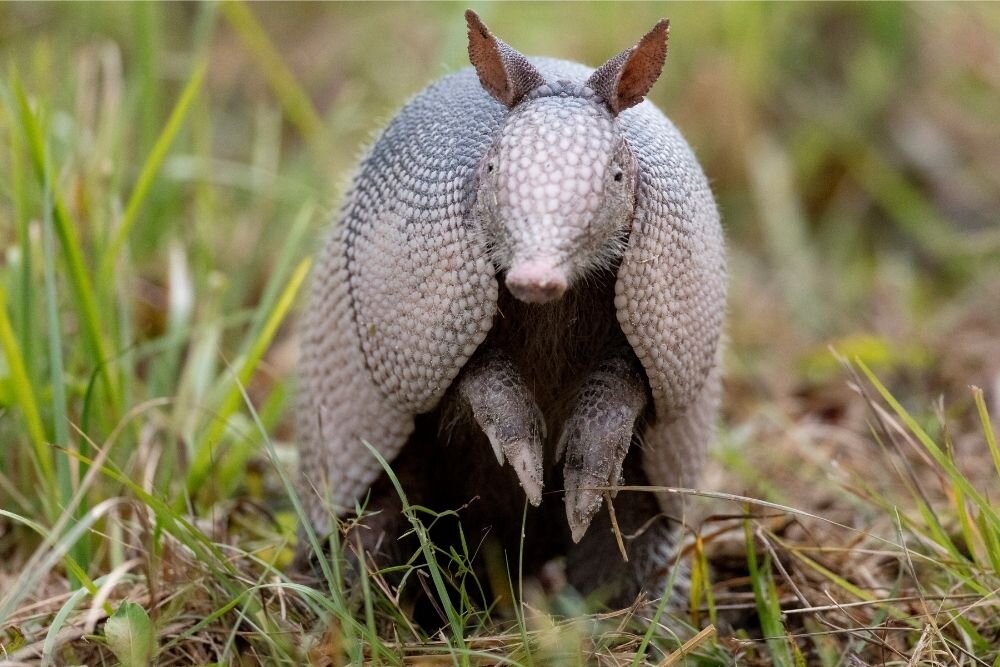Behold, the Armadillo!
Surprising to some, many of us have seen armadillos in our immediate area. These unusual looking animals have only reached Tennessee in the last 30 years or so, but their potential range continues to expand because of their rapid breeding cycle, adaptability, reduction of predators, and climate warming caused by increasing carbon in the atmosphere.
Armadillo is a Spanish word meaning “little armored one” and refers to the bony plates that cover the back, head, legs, and tail of these odd looking creatures. Armadillos are the only living mammals that wear such shells. They have also been called opossum on the half shell, Hoover hogs, and the poor man’s pig. Rumored to taste like pork, some of these names came during the Depression by those who actually ate armadillos for sustenance, blaming President Hoover for the bad times.
This heavily armored omnivore is closely related to anteaters and sloths. Armadillos generally have a pointy or shovel-shaped snout, small eyes, and short legs with well-developed claws (four toes on the front feet, five on the rear), which are used for digging burrows and searching for food. They vary widely in size and color, from the 6-inch-long, salmon-colored pink fairy armadillo to the 5-foot-long, dark-brown giant armadillo. Of the 20 armadillo species, 19 live in South America, and only the nine banded lives in the United States.
Though their name would suggest otherwise, nine-banded armadillos can have anywhere from seven to eleven bands in their armor. The nine banded armadillo ranges from 28-33” long and weighs between 6-11 lbs.
This tiny gladiator has one weak spot - the soft skinned under belly covered in yellow or white hair. Contrary to popular belief, not all armadillos are able to roll into a ball, encasing themselves in their shells when threatened. In fact, only the three-banded armadillo can, curling its head and tail together, contorting its shell into a hard ball that confounds would-be predators. In 2014, the three banded armadillo was the mascot for the World Cup in Brazil because it rolls into a soccer-like ball!
Armadillos live in temperate and warm habitats and thrive in forested areas and grasslands. Because of their low metabolic rate and lack of fat stores, cold is their enemy, and series of intemperate weather can wipe out whole populations. Because they must dig for their food and shelter, they generally gravitate towards areas with loose, porous soil. In native southern regions, armadillos are nocturnal year-round, keeping cool underground during the day and foraging at night. However, because of the armadillos' relatively low body temperature, the nine-banded species in North America tends to change its habits in the cooler months and emerge during the day to take advantage of the warm sun.
Armadillos dig multiple burrows throughout their home range. They sleep a lot in their burrows – up to 16 hours per day! Burrows also provide refuge from extreme weather or predators. An armadillo burrow is about 7-8" wide and up to 15’ deep. Abandoned burrows may be utilized by other animals, such as pine snakes, rabbits, opossums, mink, cotton rats, striped skunks, burrowing owls, and eastern indigo snakes.
Strong legs and huge front claws make for an accomplished digger, coming in handy when you have to dig up your food. Armadillos can smell their food up to 6” underground! With over 90% of their diet consisting of insects, armadillos forage for beetles, ants, termites, and other insects. They have very poor eyesight, and use their keen sense of smell to hunt. Long, sticky tongues are used to extract ants and termites from the earth. Additionally, armadillos are known to snack on small reptiles or amphibians, some plants and fruit, as well as the occasional carrion meal.
Good swimmers, armadillos can inflate their stomach and intestines to work as ballasts to stay afloat countering the weight of their heavy shells. This process enables them to swim versus walk underwater. The armadillo can choose to walk underwater across the bottom of a stream or small river while holding its breath for up to six minutes!
Mating occurs during the months of July and August in North America with only a single egg being fertilized. The gestation period is approximately 4 months. The female armadillo can control when the egg is fertilized, delaying pregnancy for several months or years, if needed. Normally, this is done when the female is under stress. The nine banded armadillo is polyembryonic, always giving birth to same sex identical quadruplets from a single fertilized egg!
Golf ball sized babies are born with soft shells that harden over time. They remain in the burrow during the first few months of life, suckling mother’s milk. After this time, they will begin foraging with their mother and then set out on their own anywhere from six months to a year of age and remain solitary except to breed.
An armadillo’s predators include coyotes, bears, cougars, other wildcats, wolves, dogs and humans. Many armadillos are killed by cars or hunted by humans. Humans have killed off most of their natural predators, and roadways have offered them easier means of travel to new habitats. Nine-banded armadillos have a tendency to jump straight up into the air when they are startled. This often leads to their demise on highways. Armadillos live 7-10 years in the wild.
Armadillos have gotten a bad reputation because they have the ability to carry the bacterium that causes leprosy in humans. However, the risk of contracting leprosy from an armadillo is extremely low. Armadillos are valuable to scientists in the study of leprosy.
This brave, determined and very unique rolling tank is the only mammal to have external bony plates and is the only surviving family of Cingulata. Five other families in this order are extinct and are known only from fossil remains. Keep your eye out for this living dinosaur as you enjoy your time outdoors!



